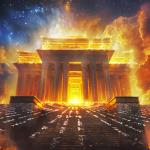
Historically, humans have viewed space and time as separate and distinct entities. Space, often considered a three-dimensional realm of locations, shapes, and distances — defined by width, length and height – was seen as a static backdrop for the unfolding of events within a separate, fixed, linear reality of time.
Einstein’s Theory of Relativity revolutionized this view, introducing the concept of Spacetime. In this view of the Universe, space and time are intertwined, inseparable and relative in terms of how they will be perceived relative to Time Dilation — not absolute, fixed units. In other words, time is not absolute but relative to the observer’s frame of reference. This means that time can pass at different rates for different observers, depending on their speed or gravitational potential. Einstein determined that the laws of physics are the same for all stationary, non-accelerating observers — but that events which occur at the same time for one observer could occur at different times for another.
Sir Isaac Newton (1643 – 1727) quantified gravity in the same text in which he formulated his three laws of motion, the Philosophiæ Naturalis Principia Mathematica (1687). The gravitational force tugging between two bodies depends on how massive each one is and how far apart the two lie. For example, as the center of the Earth is pulling you toward it, your center of mass is pulling back at the Earth. But the more massive body barely feels the tug from you, while with your much smaller mass, you find yourself firmly rooted because of that same gravitational force. Newton’s laws, however, wrongly assumed that gravity is an innate force of an object that can act over a distance.
Today, physicists know better. We now refer to time as the fourth dimension, alongside the three spatial dimensions of length, width, and height. This means that events occur in an interconnected four-dimensional Spacetime. Gravity and time are interwoven, with the presence of mass affecting not only spatial dimensions but also the flow and perception of time.
Einstein combined all of these ideas in his 1905 theory of Special Relativity, which postulated that the speed of light was constant. For this to be true, space and time had to combine into a single framework that together keep the speed of light the same for all observers.
Far from a “theory” in the commonly perceived sense of the work, Einstein’s Theory of Relativity, both Special and General, has been extensively tested and confirmed over the past century. Countless experiments and observations across various scales, from atomic to galactic, consistently support its predictions, with ongoing research further refining and strengthening its foundations.
The General Theory of Relativity, which Einstein published in 1915, expanded the theory of Special Relativity that he had published 10 years earlier. Special Relativity argued that space and time are inextricably connected, but that theory didn’t acknowledge the existence of gravity. Einstein spent the decade between the two publications determining that particularly massive objects warp the fabric of Spacetime, a distortion that manifests as gravity. Einstein’s subsequent General Theory of Relativity fundamentally overturned the perspectival assumption of the very notion of a universal, linear “now.”
Live In the Now?
We often hear the advice to “live in the now.” While that is relatively correct, it is only that — relative to our perspective of Spacetime. There is never a tangible “now,” only a conceptual one. As soon as one thinks of the now, it is gone and replaced by now.
Now, now, now, now, now!
What is this now?
Now is an illusion because time is an illusion. As we know time is illusory, it only serves to reason that spacial dimensionality is illusory as well.
So Spacetime is an illusion – now is an illusion. What is left?
String Theory reasons that just as the ancients from Abraham to Laozi said, there are essentially ten dimensions, of which our consciousness is anchored within three.. or four.
In what the Qur’an calls the Suhuf Ibrahim – the Scrolls of Abraham – known in Judaism as Sefer Yetzirah, it is explained that there is an illusion of 9 or even 11, but the reality is that there are only ten dimensions. One of these traverses the hyperspace dimensions, into the spacial dimensions. When this manifests within spacial dimensionality, we refer to it as “gravity” or Time-Dilation.
Confused yet?
Hold that thought. Let’s get into how this relates to religion.
Muhammad is reported in Hadith literature as saying that “Allah is Time.” In a Hadith narrated by Abu Huraira, we read that Muhammad was reported to have said: “Allah declared: ‘The offspring of Adam abuse the Aeon, Time, Ad-Dahr (الدهر), and I am the Dahr; in My Hands are the night and the day!”
حَدَّثَنَا يَحْيَى بْنُ بُكَيْرٍ، حَدَّثَنَا اللَّيْثُ، عَنْ يُونُسَ، عَنِ ابْنِ شِهَابٍ، أَخْبَرَنِي أَبُو سَلَمَةَ، قَالَ قَالَ أَبُو هُرَيْرَةَ ـ رضى الله عنه ـ قَالَ رَسُولُ اللَّهِ صلى الله عليه وسلم: قَالَ اللَّهُ يَسُبُّ بَنُو آدَمَ الدَّهْرَ، وَأَنَا الدَّهْرُ، بِيَدِي اللَّيْلُ وَالنَّهَارُ
The term Dahr (دهر) means Time but also indicates an Eon (Aeon), an Age or Epoch or an Era. Thus, it is not merely the concept of Time, but a Time Eternally. Any amount of Time, no matter how large or seemingly Infinite, it is being claimed here as an aspect of Allah’s very Being.
It is worth noting that the Arabic for the Day here is An-Nahaar, which is connected to the word for River or Nahar (نهار) – indicating the flow of the proverbial “River of Time” – or we might propose the Nahar an-Nahaar (نهر النهار).
If Allah is Time, however, then Allah must be “Space” as well. Why is that?
We know that Spacetime is One, and not coincidentally the fundamental Qur’anic and Biblical description of the Creator is Oneness, or Tawhid. Indeed, the Jewish mantra of the Shema repeats that the Verbal Supreme Name of the Creator (Y-H-V-H) is One. Clearly no one needs reminded that one single word is numerically a single word.
Why say Ha’Shem – Y-H-V-H – is One – Echad – just to say that it is one word. We see that the Word is composed of three different letters, two of them repeating. So it cannot explain the numerical nature of the Word’s formation. If it means the word itself is a single word then how would this make it different than any other word? Certainly, there would be no socio-religious endurance for such a purposeless claim, let alone millennia-sustained prayer.
We might then say that it means this Name refers to a numerically single Divine being amongst a henotheistic pantheon of lesser deities, as the Biblical account seems to indicate in so many places. But if that is the case then why utilize a Verb of all things, for something that would thus clearly be referring to a noun.
Something more fundamentally profound is going on here with the Shema. The Jewish prayer mantra is tell us that while we interface with Ha’Shem as our Elohenu – our god – it is actually a Verb of Perpetual Existing, and that Verb is One. A single supreme noun concept of Divinity was nothing new. But with the Torah came the concept of a perpetual Verbal Divinity. That was not only very different, but an extremely outside-of-the-box concept, which required daily reflection and meditation upon.
Existing is One, and our Existing and that of the perceived other’s Existing are absolutely One – undivided, and just as inseparable as Time and Space.
What We Call “Gravity” is Time-Dilation
So returning to the question of “What is this now?” – the Now is Time-Dilation… Gravity. This is the perspectival observation of time passing at different rates in varying gravitational fields, with stronger fields causing time to move slower.
So does this mean then that there is a fixed time which we – within it – are subjected to experiencing differently depending on our relationship to spacial mass and gravity?
Yes. Certainly.
But at the same time, this could lead us to imagine a now which was now at a past point in time or Spacetime, which moved on in a linear timeline and is now present here and now as these words are written… but then just got away from us as we tried to perceive it, and instead it is here – now!
Traditionally, gravity was perceived as a separate and distinct force acting at a distance. This view, however, has evolved significantly with Einstein’s General Theory of Relativity, which demonstrates that gravity is intrinsically linked to the curvature of space-time caused by mass, indicating that mass directly influences the geometric structure of both space and time as inseparable Spacetime (Araújo, 2022; , Sobral-Blanco, 2021). This view implies that the perception of time as flowing from past to present to future may be an illusion, a simplification of a more complex, potentially timeless reality.
All of this leads to a discussion as fascinating as it would be derailing from the focus of the topic at hand (albeit related), regarding the reconciliation of the various String Theories in M Theory, and Time Dilation as the enigmatic “11th Dimension” which traverses Hyperspace Dimensionality into the material three dimensions (as the aforementioned fourth). That deeply involved discussion must be reserved for another day, after the topic at hand has been fundamentally established.
This phenomenon has been confirmed by experiments such as the Hafele-Keating experiment, where atomic clocks on airplanes experienced different time readings compared to those on the ground (Arneth, 2024). Transmission of Time Dilation in Quantum Contexts: Emerging studies have also begun to analyze time dilation through the lens of quantum mechanics. Recent applications of quantum interferometry highlight that time dilation effects can manifest differently when atomic clocks are in a superposition of states, leading to quantum gravitational time dilation implications (Paczos et al., 2024; Khandelwal et al., 2020).
Despite the secure footing of time dilation within the realm of physics, discussions often extend into psychological perceptions of time. Research indicates that time perception varies based on stimuli and attentional resources, illustrating that factors influencing subjective experiences of time can complicate our understanding of time as a physical phenomenon (Choe & Kwon, 2022; Kent et al., 2019; Pikovski et al., 2015).
Some physicists propose that time may emerge from more fundamental, timeless processes within the universe, such as quantum entanglement or thermodynamics, or even some form of Loop quantum gravity, a theory attempting to reconcile general relativity with quantum mechanics, suggesting that time may be quantized in discrete units rather than continuously. This, of course, would need to be reconciled with M Theory. If that is ever articulated, it would likely form the backbone of the coveted “Theory of Everything.”
The Omniscient Observer
The Qur’an famously proclaims 99 Names or Divine Attributes of Allah, throughout its suwar. One of these is Ar-Raqib (ٱلرقيب), the Watcher, the Observer. The R-Q-B (ر – ق – ب) root indicates the neck of a body, or a military sergeant – meaning one who over-sees – able to look this way or that. It is an obviously flawed anthropomorphic analogy, but this is the nature of any such description. Even the pronoun Hu defaults to gender neutrality in an otherwise rigidly gendered language (much more so than Hebrew even). As the Qur’an says, “there is nothing comparable to Hu” wa-lam yakun lahu kufu’an Achad (ولم يكن لهۥ كفوا أَحدٌۢ). Notice here the same concluding Arabic word Achad as in the aforementioned Hebrew Shema – Echad.
Maimonides (Abu `Imran Musa bin Maimun bin `Ubayd’allah al-Qurtubi),[3] also known as the Rambam (1138–1204), famously employed a system of negative theology to describe the Creator. This, however, was delineated only after establishing the usefulness of allegorical positive descriptions.
In chapter fifty-eight, entitled “Deeper than What Came Previously,” of the first volume of The Guide for the Perplexed (1190) or Dalalat al-Cha’irin in its original Judeo-Arabic (Hebrew: Moreh Ha’Nevukhim), the Rambam presents a system of negative theology to describe the Creator. In this, he emphasizes what the Divine is not rather than what It is. This approach, also known as apophatic theology, aimed to preserve the Creator’s uniqueness and transcendence by acknowledging that human language and concepts are inadequate to grasp the Divine Reality.
The Rambam thus employs examples like “Allah is not corporeal,” and “Allah is not limited by space,” or “Allah does not have parts” to illustrate the Divine transcendent nature of the Creator. The Rambam’s negative theology is not a denial of positive attributes, such as the Qur’anic 99 Names — which certainly have their Biblical parallels and precedences, but rather a method for clarifying how they apply to to the Creator. For instance, while we can say Ha’Shem or Allah is the Wise, we understand this in a way different from how humans use the word Wisdom.
Nearer than your jugular vein
In one of the most often cited ayat in all of Tasawwuf (Sufism), we read of Allah, speaking in something of a Hive-Mind Divine Plurality:
Indeed, We created Humankind and know what its ego whisper to it – and We are nearer [to Humankind] than [Humankind is] from [their] jugular vein. 50:16
وَلَقَدْ خَلَقْنَا ٱلْإِنسَـٰنَ وَنَعْلَمُ مَا تُوَسْوِسُ بِهِۦ نَفْسُهُۥ ۖ وَنَحْنُ أَقْرَبُ إِلَيْهِ مِنْ حَبْلِ ٱلْوَرِيدِ
The word for Humankind here is not the common nas, from the obvious cognates enosh and Anashim (אנשים). Instead, the ayah employs a particularly Sufi key word: Insan (ٱلْإِنسَـٰنَ). This is used throughout all Sufi turuq in reference to the concept of the Perfected Human – the Insan al-Kamil. While this is commonly used in Modern Arabic to mean human beings, in Classical, Qur’anic Arabic, its meaning is not that simple. Instead of simply meaning human, the term insan is a description attributed to humankind. The word derives from the Arabic root meaning to forget or nisyah. The Insan al-Kamil then is one who has had their forgetfulness perfected – that is, one who remembers.
What does this mean though? How can Allah be nearer than your jugular vein, unless this is a statement of pure pantheism?
There is a saying that the devil is in the details, and this phrase is perfectly exemplified here. The devil or diablos (note the Qur’anic Iblis) – the deceiver, or perhaps simply the concept of deception – here can be found in the lax and lazy conflation of pantheism and panentheism.
In the first case, one assumes the inherent realness of materialism and declares physicality to be filled with the Divine. That’s an understandable assumption to make, particularly if one delves shallowly into the philosophical concept of the impossibility of Divine separation from a thing without simultaneously being limited by that separation.
There is, however, another explanation: that perceived material reality is an illusion, just as the forms and images within a dream are real within the perception of the perceiver, yet those forms and images are in no way separate from the consciousness of the dreamer. Here then we have the concept of panentheism – the idea that all things are within the Mind of the Divine, rather than there being real things which the Divine is within. Certainly, we can say that the Divine is within the illusory things within It’s Mind, but those things are fundamentally Imagined, and have no independent reality unto themselves. Thus, pantheism is philosophically stopping halfway there.
L’Dor v’Dor
In the Biblical Book of Daniel (2:2o) we read: “Blessed be Ha’Shem of God from the Eternal Past to Eternity Future.”Here in the Aramaic portion of Sefer Daniel, we read: min `alma v`ad `alma – what would in Hebrew be rendered as the common phrase l`olam v`ed. “For wisdom and power are to Hu [Alone]!”
עָנֵה דָנִיֵּאל וְאָמַר לֶהֱוֵא שְׁמֵהּ דִּי אֱלָהָא מְבָרַךְ, מִן עָלְמָא וְעַד עָלְמָא דִּי חָכְמְתָא וּגְבוּרְתָא דִּי לֵהּ הִיא
The term `Olam, for the World or Universe, is not only being used to designate subsequent and future time (Berashit/Genesis 13:15; Shmot/Exodus 14:13; Devarim/Deuteronomy 13:16; 23:3; 29:29; Yehoshua`/Joshua 8:28; Mikhah/Micah 4:7), but also remote antiquity (Berashit/Genesis 6:4; Devarim/Deuteronomy 32:7; Mikhah/Micah 5:2). All Time then, is related to the Existing of the Ever-Living, Eternal Verb of Ha’Shem (Yoel/Joel 2:1-11)
The meaning “forever” is paralleled with the expression “for a thousand generation(s)“ Divrei Ha’Yamim Alef/1 Chronicles 16:15 – note – the Hebrew word for generation in this verse is “dor” (דור) and it is singular. To express “forever” more precisely one can find the phrase dor v’dor (דור ודור) “forever, from generation to generation.
It might be obvious that the Hebrew term dor (דור) here is the cognate with the Arabic Dahr (دهر). The term for sphere, circle, or ball in Hebrew is spelled identically — dur (דור).
The noun dor here is derived from the verb dur – meaning to encircle. Ancient Israelites used this word for “to heap up” or “to pile something” — thinking graphically of the shape of the heap at its base, rather than as we, of the height or outline of the elevation created. As well, since in ancient times houses or even tribal huts, or Sukkot were typically grouped circularly, surrounding a central court or communal area, the word was employed with the meaning of to dwell.
The word Dahr is mentioned two times in Qur’an. In the first ayah of Surat al-Insan, Allah talks about an Epoch from the Time (حِينٌۭ مِّنَ ٱلدَّهْرِ) before the creation of the physical world. We Al-Insan was not present, but Allah was.
“Was there not an Epoch from the Time (hinun min ad-Dahr), when the Forgetful Human — Al-Insan — was nothing to even be mentioned” (76:1)?
هَلْ أَتَىٰ عَلَى ٱلْإِنسَـٰنِ حِينٌۭ مِّنَ ٱلدَّهْرِ لَمْ يَكُن شَيْـًۭٔا مَّذْكُورًا
For the Universe, time started with the Big Bang approximately 18 billion years ago, relative to our terrestrial, solar reckoning. We are reminded, however, of the relativity of Time, or Spacetime more accurately, in the Qur’anic ayah which repeats the Biblical concept, from Tehillim (Psalms 90:4), of a year in the Sight of Ha’Shem being as one thousand years — ki elef shanim, be’eineikha, k’yom etmol, ki ya’avor (כִּי אֶלֶף שָׁנִים בְּעֵינֶיךָ כְּיוֹם אֶתְמוֹל כִּי יַעֲבֹר).
“Verily a Day in the Sight of your Lord is like a thousand years of your reckoning” (22:47)
وَيَسْتَعْجِلُونَكَ بِٱلْعَذَابِ وَلَن يُخْلِفَ ٱللَّهُ وَعْدَهُۥ ۚ وَإِنَّ يَوْمًا عِندَ رَبِّكَ كَأَلْفِ سَنَةٍۢ مِّمَّا تَعُدُّونَ
It was to this end that, Anas bin Malik narrated that Muhammad was reported as saying: “The Hour will not be established until Time is constricted, and the year is like a month, a month is like the week, and the week is like the day, and the day is like the hour, and the hour is like a spark of fire.”[4]
حَدَّثَنَا عَبَّاسُ بْنُ مُحَمَّدٍ الدُّورِيُّ، حَدَّثَنَا خَالِدُ بْنُ مَخْلَدٍ، حَدَّثَنَا عَبْدُ اللَّهِ بْنُ عُمَرَ الْعُمَرِيُّ، عَنْ سَعْدِ بْنِ سَعِيدٍ الأَنْصَارِيِّ، عَنْ أَنَسِ بْنِ مَالِكٍ، قَالَ قَالَ رَسُولُ اللَّهِ صلى الله عليه وسلم “ لاَ تَقُومُ السَّاعَةُ حَتَّى يَتَقَارَبَ الزَّمَانُ فَتَكُونُ السَّنَةُ كَالشَّهْرِ وَالشَّهْرُ كَالْجُمُعَةِ وَتَكُونُ الْجُمُعَةُ كَالْيَوْمِ وَيَكُونُ الْيَوْمُ كَالسَّاعَةِ وَتَكُونُ السَّاعَةُ كَالضَّرْمَةِ بِالنَّارِ ” . قَالَ أَبُو عِيسَى هَذَا حَدِيثٌ غَرِيبٌ مِنْ هَذَا الْوَجْهِ . وَسَعْدُ بْنُ سَعِيدٍ هُوَ أَخُو يَحْيَى بْنِ سَعِيدٍ الأَنْصَارِيِّ .
Similarly, we read of what the Ahl al-Bayt regarded as Yom al-Qiyamah – the Era of Resurrection – that far from being a 24 hour “day” this “Yom” will be 50,000 years in length, relative to our solar system and planet.
“Unto Hu, the Divine Messengers, Al-Mala’ikah, and the Ruh, the Spirit will Ascend – in a Day whose length is fifty thousand years” (70:4).
By some accounts, Maitreya will lead all beings still trapped in the cycle of rebirths to nirvana. Others maintain that he will preach for 60,000 years, after which he will enter nirvana and his doctrine will endure for another 10,000 years. This is remarkably similar to the 50,000 year Zaman al-Masih or Era of the Messiah in Islam. It is mentioned in the Qur’an as the day whose measure is 50,000 years. This is clarified by the great `Arif Mulla Sadra who accurately interpreted that this 50,000 year “Yawm” is the Day of Resurrection, or “Yawm Al-Qiyyamah.”
“Al-Mala’ikah (The Angels) and Ar-Ruh (the Spirit/Primordial Messiah) Ascend unto Hu (Allah) in a Day the measure whereof is 50,000 years.” Al-Qur’an, Sura 70:4
تَعْرُجُ الْمَلَائِكَةُ وَالرُّوحُ إِلَيْهِ فِي يَوْمٍ كَانَ مِقْدَارُهُ خَمْسِينَ أَلْفَ سَنَةٍ
In Sura 70:4 we are told that the Malaikah and the Ruh will Ascend to Hu over the course of 50,000 Dunya years. This refers to the 50,000 year Zaman Al-Masih that will transpire after the Rise of Al-Qa’im (عجل الله تعالي فرج الشريف) and the 309 Reign of Mahdi Al-Hussayn (عجل الله تعالي فرج الشريف), the successor to Imam Al-Mahdi (عجل الله تعالي فرج الشريف).
Mulla Sadra commented on these Quranic words by explaining that “those of old (al-awwalin)” means “your fathers and those who came before you.” “Those of later time (al-akhirin)” stands for “those who will come after your time.” He interprets the words “an appointed day (miqat yawm ma’lum)” as “the time of promise (ajal) that Allah appointed to his servants, and the Day of Resurrection (yawm al-qiyamah).” After a brief quotation from al-Zamakhshari’s Qur’anic commentary on a grammatical point, he interprets the Day as follows:
“It is a day which encompasses all the created, for it includes all days on account of its extent being fifty thousand years. In a similar way, the Earth of the place of resurrection (mahshar) has the capacity to receive all of them, for it contains all the earth. This is confirmed by `Urafa (Mystics). The ma’iyah (togetherness) with, and the jam’iyah (comprehensiveness) of the created are of a kind different from that of temporal or spatial togetherness. In what mode is it? The totality of separate times does not constitute another time and the totality of separate spaces does not constitute another space. The totality of al-dar (this world) has no world except in the sense that it has another mode of being.”
Here, again, we see reference to Ha’Shem as the Watcher or Observer, just like the Qur’anic Raqib.
What is the significance here?
Observation and Quantum Collapse
In the field of Quantum Physics, it is now understood a quantum system exists in a superposition of multiple potential states
These potential outcomes exist only in potentia until an observation causes the wave function to collapse to a single state.
This phenomenon is commonly referenced in Pop Culture with the famous — yet hopelessly flawed — thought experiment involving Schrödinger’s cat. which is In this theoretical scenario, a cat in a closed box is both alive and dead until the box is opened and the cat is observed. The obvious anthropocentric problem with this thought experiment is the fact that the cat too is sentient and thus is observing the goings-on within the box. Nevertheless, suspending our disbelief in this obvious flaw, the point remains that in quantum mechanics, the role of the observer in this collapse is critical.
Quantum Physics explains that observational acts actively participate in the determination of physical realities.
This concept has notoriously been driven into the ground by Marvel Comics. In Deadpool and Wolverine (2024), Deadpool gives a monologue about how the Multiverse as a plot concept isn’t working within the Marvel Comic Universe. Nevertheless, the Marvel executives and decision-makers, Deadpool laments, seem tone-deaf to this reality. This plot scenario falls flat particularly because Marvel has depicted it in a completely incorrect manner, where each potential reality actually exists — not in potentia, but each with independent Universes unto themselves. While this tends to be how the concept is described in popular culture and media, this is not at all what the science indicates.
In this misunderstanding of the Many Worlds Theory, each potential outcome represents a branching of realities into multiple non-communicating parallel worlds, which exist simultaneously. This theory offers an alternative to the Copenhagen interpretation, which correctly posits that the wave function collapse leads to a definitive state upon measurement (Frauchiger & Renner, 2018; Aguirre & Tegmark, 2011). Potential realities exist in potentia but only one reality is cemented and given form upon the collapse of the quantum state resultant from observation.
However, the many-worlds interpretation does not propose an actual collapse; instead, it suggests that every possible outcome occurs in its own branch of the universe. Research has suggested that consciousness may play a role in this observational process; some theories posit that measurement by a conscious observer leads to the wave function’s collapse (Jansen, 2008).
This interpretation aligns with various philosophical perspectives concerning the relationship between consciousness and the physical world, suggesting that cognitive frameworks could be integral to the formation of observable realities. Moreover, recent developments in quantum theory challenge traditional views regarding wave function collapse, presenting frameworks in which collapse is viewed as an inherent property of the quantum system itself rather than solely the result of an observation. For instance, some approaches to quantum mechanics propose that quantum state evolution may be subject to random fluctuations that induce collapse independently of observation (Chiarelli & Chiarelli, 2024; Chiarelli & Chiarelli, 2024).
Such models aim to resolve ambiguities related to measurements and the resultant realities by introducing fundamental unpredictability in quantum state evolution. In summary, the existence of potential realities until observation highlights the complex interaction between measurement and physical state determination in quantum mechanics. The collapse of the wave function serves as a critical point where probabilistic outcomes convert into tangible realities, underscoring profound implications for our understanding of consciousness and reality itself.
“And they say: ‘What is there but our life in this world? We shall die and we live, and nothing but the Dahr can destroy us.’ But of that they have no knowledge, they follow only conjecture” (45:24).
The Qur’an here indicates the irony of their ignorant statement that only the Dahr can destroy them – rather than Allah – since Allah is the Dahr. The very thing they acknowledge can destroy them is the same which they deny. To this end, one might recall the statement by Albert Einstein that “the god the atheist does not believe in, I do not believe in either.”
“And truly, We will recount their entire story with Complete Knowledge, for We were never absent.” (7:7)
Notes:
`Ubayd’allah is Maimonides’ surname; his grandfather was named Yusuf or Yosef, though not always included in either Arabic or Hebrew versions of Maimonides’ name. Numerous Hebrew manuscripts render ben Ovadyahu and ben `Eved-Elohim – meaning descended from, or son of `Ovadyah.
The designations `Ovadyah, or `Eved-Elohim in Hebrew, or its Arabic equivalent `Abdullah, can also simply be used to imply “Moses son of Maimon, the servant of Yah” or “Elohim” or “Allah,” respectively (cf. Sefer Yehoshua`/Joshua 1:13-15). Medieval Jews named Musa (in Arabic) or Mosheh (Moses) in Hebrew, received the Arabic nickname “Son of `Amran” or “Abu `Imran.”
In this kunya nicknaming scheme, the word Abu is inverted from its original sense of “father” to reference the biblical Moses’ father `Amram. Similarly, Jews named Yitzchaq or Ishaq were known as Abu Ibrahim, meaning in this inverted case: “Son of Abraham”. Since the Biblical Mosheh Rabbeinu was the son of `Amran, the Rambam being named after the great Lawgiver, was called “Son of `Amran.”
Yet, since this might confuse contemporaries – particularly in the absence of a father who was deceased and whose name was thus not commonly known to one’s immediate community, the inversion of Abu make it a clear reference, rather than ibn or bin, since it would have been well-known that the Rambam’s only son was not named `Amran but Avraham.
[4] Isnad traditionally graded as Sahih; Compiled in Jami` at-Tirmidhi 2332 Book 36, Hadith 29; Eng. Vol. 4, Book 10, Hadith 2332References:
Abramson, N. (2014). Holodiagram: elliptic visualizing interferometry, relativity, and light-in-flight. Applied Optics, 53(11), 2398. https://doi.org/10.1364/ao.53.002398
Aguirre, A. and Tegmark, M. (2011). Born in an infinite universe: a cosmological interpretation of quantum mechanics. Physical Review D, 84(10). https://doi.org/10.1103/physrevd.84.105002
Annamalai, C. (2023). Lorentz factor and time dilation on the special theory of relativity. SSRN Electronic Journal. https://doi.org/10.2139/ssrn.4595720
Baig, M. (2018). Relativistic thermodynamics and kinetics of electrode processes.. https://doi.org/10.20944/preprints201807.0166.v1
Chiarelli, P. and Chiarelli, S. (2024). The computational universe: epr paradox and pre-measure reality, actual time in spacetime, free will and the classical limit problem in quantum loop gravity, causal dynamical triangulation and holographic principle.. https://doi.org/10.20944/preprints202403.0785.v1
Chiarelli, P. and Chiarelli, S. (2024). The computational universe: quantum quirks and everyday reality, actual time, free will, the classical limit problem in quantum loop gravity and causal dynamical triangulation. Quantum Reports, 6(2), 278-322. https://doi.org/10.3390/quantum6020020
Frauchiger, D. and Renner, R. (2018). Quantum theory cannot consistently describe the use of itself. Nature Communications, 9(1). https://doi.org/10.1038/s41467-018-05739-8
Hashimoto, Y. and Yotsumoto, Y. (2015). Effect of temporal frequency spectra of flicker on time perception: behavioral testing and simulations using a striatal beat frequency model. Timing & Time Perception, 3(3-4), 201-222. https://doi.org/10.1163/22134468-03002049
Jansen, F. (2008). Partial isomorphism of superposition in potentiality systems of consciousness and quantum mechanics. Neuroquantology, 6(3). https://doi.org/10.14704/nq.2008.6.3.184
Pariyadath, V. and Eagleman, D. (2007). The effect of predictability on subjective duration. Plos One, 2(11), e1264. https://doi.org/10.1371/journal.pone.0001264
Petit, G. and Klioner, S. (2008). Does relativistic time dilation contribute to the divergence of universal time and ephemeris time?. The Astronomical Journal, 136(5), 1909-1912. https://doi.org/10.1088/0004-6256/136/5/1909
Özoğlu, E. and Thomaschke, R. (2020). Early posterior negativity indicates time dilation by arousal. Experimental Brain Research, 239(2), 533-543. https://doi.org/10.1007/s00221-020-05991-9















